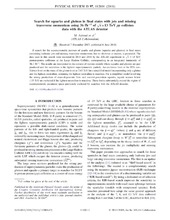Search for squarks and gluinos in final states with jets and missing transverse momentum using 36 fb−1 of √s=13 TeV pp collision data with the ATLAS detector
Aaboud, Morad; Aad, Georges; Abbott, Brad; Abdinov, Ovsat Bahram oglu; Abeloos, Baptiste; Abidi, Syed Haider; AbouZeid, Hass; Abraham, Nadine L.; Abramowicz, Halina; Abreu, Henso; Buanes, Trygve; Dale, Ørjan; Eigen, Gerald; Liebig, Wolfgang; Lipniacka, Anna; Martin dit Latour, Bertrand; Mæland, Steffen; Stugu, Bjarne; Yang, Zongchang; Zalieckas, Justas; Bugge, Magnar Kopangen; Cameron, David Gordon; Catmore, James Richard; Feigl, Simon; Franconi, Laura; Garonne, Vincent; Gjelsten, Børge Kile; Gramstad, Eirik; Morisbak, Vanja; Nilsen, Jon Kerr; Oppen, Henrik; Ould-Saada, Farid; Raddum, Silje Hattrem; Read, Alexander Lincoln; Røhne, Ole Myren; Sandaker, Heidi; Serfon, Cédric; Stapnes, Steinar; Vadla, Knut Oddvar Høie; Abreu, Rômulo F.; Abulaiti, Yiming; Acharya, Bobby S.; Adachi, Shunsuke; Adamczyk, Leszek; Adelman, Jareed; Adersberger, Michael; Adye, Tim; Affolder, Anthony Allen; Agatonovic-Jovin, Tatjana; Agheorghiesei, Catalin; ATLAS, Collaboration
Peer reviewed, Journal article
Published version

Åpne
Permanent lenke
https://hdl.handle.net/1956/19074Utgivelsesdato
2018-06-06Metadata
Vis full innførselSamlinger
Originalversjon
https://doi.org/10.1103/physrevd.97.112001Sammendrag
A search for the supersymmetric partners of quarks and gluons (squarks and gluinos) in final states containing hadronic jets and missing transverse momentum, but no electrons or muons, is presented. The data used in this search were recorded in 2015 and 2016 by the ATLAS experiment in √s=13 TeV proton-proton collisions at the Large Hadron Collider, corresponding to an integrated luminosity of 36.1 fb−1. The results are interpreted in the context of various models where squarks and gluinos are pair produced and the neutralino is the lightest supersymmetric particle. An exclusion limit at the 95% confidence level on the mass of the gluino is set at 2.03 TeV for a simplified model incorporating only a gluino and the lightest neutralino, assuming the lightest neutralino is massless. For a simplified model involving the strong production of mass-degenerate first- and second-generation squarks, squark masses below 1.55 TeV are excluded if the lightest neutralino is massless. These limits substantially extend the region of supersymmetric parameter space previously excluded by searches with the ATLAS detector.
